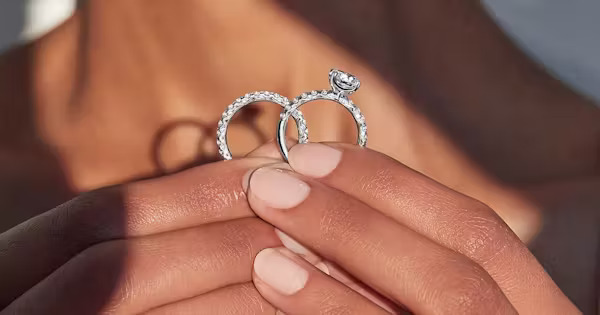
Choosing between platinum and white gold is a decision that impacts both the style and longevity of your jewelry. In our direct comparison, we dissect the crucial elements – cost, wear, and aesthetics – to give you clarity on platinum vs white gold, enabling you to make a choice that aligns with both your budget and taste.
- Key Takeaways
- Understanding Platinum and White Gold
- Qualities of Platinum vs White Gold
- Price Point and Long-Term Value
- Durability and Wear
- Hypoallergenic Benefits & Sensitive Skin Considerations
- Style Guide: Matching Metals with Gemstones
- Wedding Band Compatibility
- Summary
1 KEY TAKEAWAYS
-
Platinum is a dense, naturally white metal that is 95% pure, does not require rhodium plating, and maintains its color consistently, whereas white gold is an alloy that is often plated with rhodium to enhance its whiteness and requires more maintenance over time.
-
The initial cost of platinum jewelry is typically higher than white gold due to its greater density and purity, but platinum generally requires less maintenance and is more durable over the long-term, potentially offering better value retention.
-
Platinum is hypoallergenic and suitable for people with sensitive skin, as it usually does not contain allergenic metals like nickel, while white gold’s alloy composition can include nickel and may cause allergic reactions if the rhodium plating wears off.
2 UNDERSTANDING PLATINUM AND WHITE GOLD
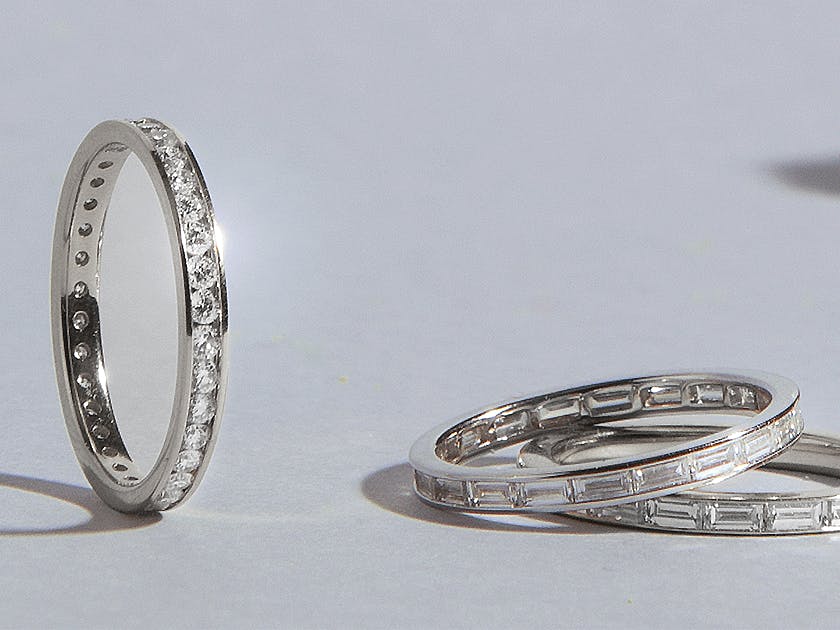
Platinum and White Gold Rings from VRAI
Platinum and white gold, two of the most popular metals for fine jewelry, carry their distinct qualities and characteristics. While they may appear similar to the untrained eye, their differences lie in their composition and natural properties. Whether it’s a timeless engagement ring or a pair of chic earrings, understanding these metals can help you make the right choice for your jewelry.
Composition of White Gold
White gold is created by blending pure gold with other white metals like nickel, palladium, or silver to form an alloy. This results in a beautiful and durable metal that is popular in jewelry making. The exact composition varies depending on the desired level of purity and color, with typical mixtures ranging from 9ct, composed of 35.7% gold and roughly 62% silver, to 18ct, made up of 75% gold and 25% palladium. This blend is what gives white gold its characteristic appearance.
To further enhance its whiteness and add a shiny finish, white gold is often plated with rhodium, a precious white metal, while yellow gold maintains its natural color.
The Natural Elegance of Platinum
On the other hand, platinum is a naturally white metal known for its purity and high-end appeal. As a pure white metal, platinum jewelry typically contains 95% platinum and 5% mixed alloys such as cobalt or palladium. This high purity level contributes to platinum’s bright white shine and durability.
Unlike white gold, platinum does not require rhodium plating to maintain its color, making it an elegant and prestigious choice for fine jewelry.
3 QUALITIES OF PLATINUM VS WHITE GOLD
Having understood the basic composition of both platinum and white gold, let’s delve deeper into their distinctive qualities. Each of these metals has a unique visual appeal, weight, and design flexibility, which significantly influence their use in jewelry.
Visual Appeal: Color and Shine
When it comes to the visual appeal of these two metals, platinum stands out with its naturally bright white color, while white gold, with its rhodium plating, has a slightly more silvery hue. Over time, as the rhodium plating on white gold wears off, its natural yellowish color may become visible. On the contrary, platinum retains its color consistently.
Moreover, platinum develops a unique patina over time due to minor scratches, which many find appealing as it adds character to the jewelry.
Weight and Feel
The weight and feel of your jewelry are also significant factors to consider. Here are some points to keep in mind:
-
Platinum is heavier than white gold because it is a dense material. This substantial weight is often a matter of personal preference.
-
Some people prefer the hefty feel of platinum, associating it with a sense of luxury.
-
Others might favor white gold for its lighter feel, particularly for jewelry worn daily.
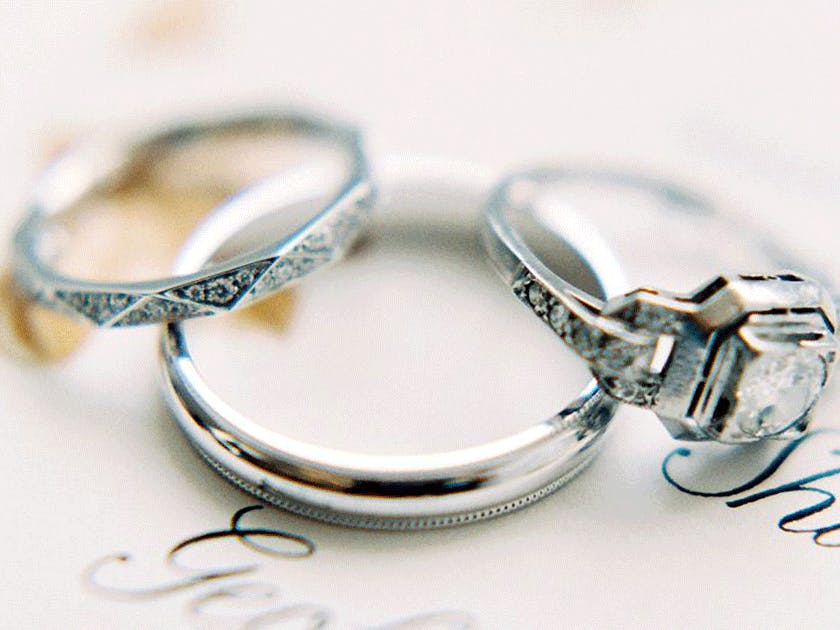
Platinum and White Gold Rings from Brides
Jewelry Design Flexibility
Beyond visual appeal and weight, the design flexibility of platinum and white gold plays a vital role in jewelry creation. Platinum, due to its malleability, allows for intricate designs and delicate patterns.
In contrast, the rigidity of white gold is advantageous for designs that require the support of small diamonds and fine details, ensuring stability and precision in jewelry settings.
4 PRICE POINT AND LONG-TERM VALUE
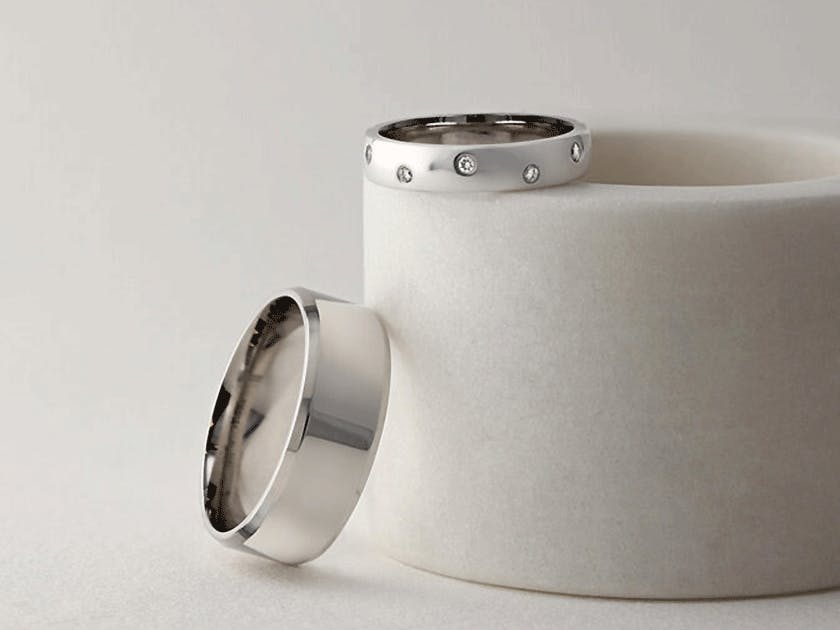
Platinum and White Gold Rings from Borsheims
After understanding the distinctive qualities of platinum and white gold, let’s delve into an equally crucial aspect: the price point and long-term value.
The choice between these two metals often boils down to an individual’s budget and their perspective on long-term investment.
Initial Investment
The initial cost of platinum jewelry is typically higher than white gold due to its higher purity level and greater density. On the other hand, white gold is less expensive upfront but may lead to additional costs for maintenance such as rhodium plating over time.
Maintenance Over Time
Maintenance is another factor to consider when looking at long-term costs. White gold requires more maintenance due to the potential need for re-plating as the rhodium finish wears off over time.
In contrast, platinum jewelry requires less frequent maintenance, often just needing a polish every few years to retain its luster.
Value Retention
In terms of value retention, precious metals, particularly platinum, a precious metal, have rarity and special attributes such as being corrosion-resistant and one of the least reactive metals, making them highly valuable.
On the other hand, the prices of gold and the metals comprising white gold can fluctuate due to market conditions, affecting the relative value of white gold jewelry.
5 DURABILITY AND WEAR
Having understood the price point and long-term value, let’s delve into another critical aspect: the durability and wear of platinum and white gold rings. This consideration is particularly important for pieces like engagement rings and wedding bands, which are typically worn daily and subject to constant wear and tear.
Scratch Resistance
When it comes to scratch resistance, platinum stands out due to its ability to displace metal rather than lose it when scratched, unlike white gold which loses a minuscule amount of metal with each scratch. This property, along with the development of a patina finish over time, contributes to platinum’s lasting durability.
Longevity and Preservation
In terms of longevity and preservation, platinum’s density and strength make it suitable for securely holding gemstones in heirloom-quality jewelry pieces. However, over time, platinum can become thinner with wear, which may affect the longevity and preservation of the piece.
When comparing white gold vs other metals, it’s important to note that while white gold is intrinsically strong and can retain fine details, over time, it may wear away and become very thin, requiring more frequent maintenance.

Platinum and White Gold Jewelry by Fox Fine Jewelry
6 HYPOALLERGENIC BENEFITS & SENSITIVE SKIN CONSIDERATIONS
Another crucial aspect to consider when choosing between platinum and white gold is their hypoallergenic properties. This is particularly important for those with sensitive skin or allergies to certain metals.
Platinum’s Hypoallergenic Properties
Pure platinum is a highly hypoallergenic metal due to its high level of purity, typically used in jewelry at 90 to 95 percent purity. This high purity level, free of common allergenic metals like nickel, makes platinum often the best choice for those with sensitive skin or metal allergies.
White Gold Allergy Potential
However, white gold may contain nickel, a common allergen, in its alloys. While white gold is typically plated with hypoallergenic rhodium, the rhodium layer can wear off over time, leading to potential exposure of the alloyed metals, including nickel, and consequently, potential allergic reactions, especially for those with sensitive skin.
7 STYLE GUIDE: MATCHING METALS WITH GEMSTONES
Now that we’ve explored the characteristics of platinum and white gold, let’s delve into a style guide for matching these metals with gemstones. The choice of metal can significantly impact the overall look and feel of the jewelry piece.
Complementing Diamond Colors
When it comes to diamonds, colorless diamonds (graded D-F) are particularly well-suited for platinum or white gold settings as they emphasize the diamond’s icy appearance. Near-colorless diamonds (graded G-J) can also appear more colorless when set in white gold or platinum, effectively enhancing their perceived value and visual appeal.
Harmonizing with Colored Gemstones
As for colored gemstones, platinum or white gold settings are frequently used with sapphires to enhance the gemstone’s deep blue color and overall appeal. Assorted gold colors, including yellow, rose, and white gold, can also be combined in jewelry designs to offer diverse color harmonies in gemstone settings.
8 WEDDING BAND COMPATIBILITY
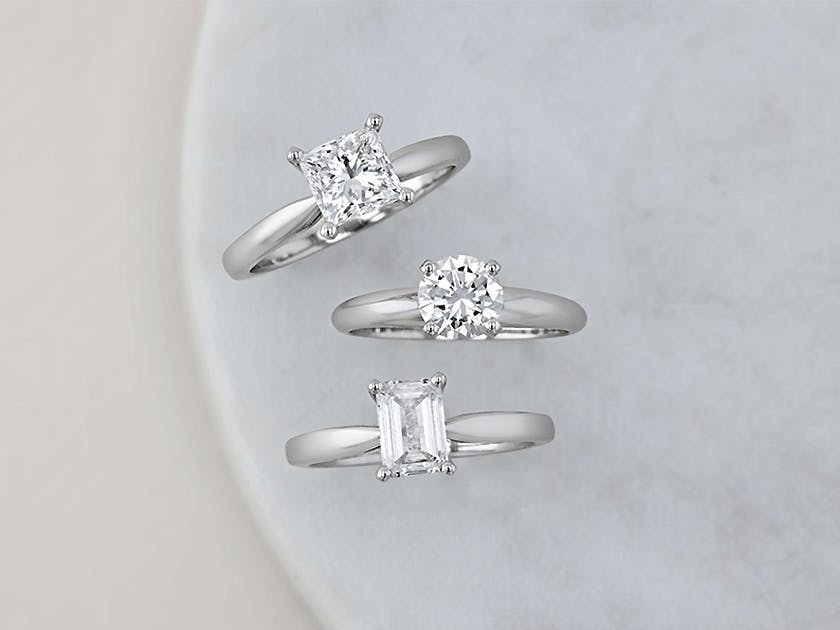
Platinum and White Gold Rings from Borsheims
Finally, let’s delve into wedding band compatibility. When choosing between platinum and white gold for your wedding band, you need to consider both the compatibility with your engagement ring and your personal style and comfort.
Matching Your Engagement Ring
Matching the metal of your wedding band with your engagement ring creates a uniform look and often enhances the overall appearance. Metals with different hardness or durability can wear each other out if not properly matched, causing more frequent maintenance or damage.
Therefore, many jewelers recommend matching the metals of engagement and wedding rings for aesthetic continuity.
Personal Style and Comfort
Beyond matching your platinum engagement ring, your personal style and comfort should also play a critical role in your decision. The final choice between platinum and white gold for your wedding band should be driven by your style preferences and individual taste, especially when considering white gold engagement rings or platinum engagement rings.
The weight and feel of the metal can also influence your decision, especially for a piece that you’ll wear daily.
9 SUMMARY
In summary, both platinum and white gold have their unique qualities and appeal. Platinum, with its natural elegance and durability, tends to be more expensive but requires less maintenance over time. On the other hand, white gold, lighter in weight and less costly upfront, may require more maintenance due to potential re-plating. When it comes to choosing between these two metals for your fine jewelry, consider your personal style, comfort, budget, and long-term value retention. Remember, the right choice is the one that makes you feel the most beautiful and comfortable wearing it.
